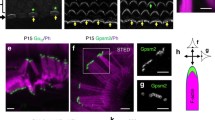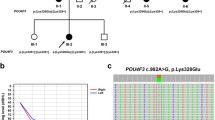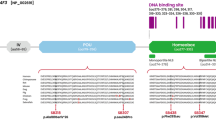Abstract
The planar cell polarity (PCP) pathway is responsible for polarizing and orienting cochlear hair cells during development through movement of a primary cilium, the kinocilium. GPSM2/LGN, a mitotic spindle-orienting protein associated with deafness in humans, is a PCP effector involved in kinocilium migration. Here, we link human and mouse truncating mutations in the GPSM2/LGN gene, both leading to hearing loss. The human variant, p.(Trp326*), was identified by targeted genomic enrichment of genes associated with deafness, followed by massively parallel sequencing. Lgn ΔC mice, with a targeted deletion truncating the C-terminal GoLoco motifs, are profoundly deaf and show misorientation of the hair bundle and severe malformations in stereocilia shape that deteriorates over time. Full-length protein levels are greatly reduced in mutant mice, with upregulated mRNA levels. The truncated Lgn ΔC allele is translated in vitro, suggesting that mutant mice may have partially functioning Lgn. Gαi and aPKC, known to function in the same pathway as Lgn, are dependent on Lgn for proper localization. The polarization of core PCP proteins is not affected in Lgn mutants; however, Lgn and Gαi are misoriented in a PCP mutant, supporting the role of Lgn as a PCP effector. The kinocilium, previously shown to be dependent on Lgn for robust localization, is essential for proper localization of Lgn, as well as Gαi and aPKC, suggesting that cilium function plays a role in positioning of apical proteins. Taken together, our data provide a mechanism for the loss of hearing found in human patients with GPSM2/LGN variants.








Similar content being viewed by others
References
Almomani R, Sun Y et al (2013) GPSM2 and Chudley-McCullough syndrome: a Dutch founder variant brought to North America. Am J Med Genet Part A 161A(5):973–976
Bhonker Y, Ushakov K et al (2014) Human gene discovery for understanding development of the inner ear and hearing loss. In: Romand R, Varela-Neito I (eds) Development of auditory and vestibular systems. Academic Press, New York, pp 107–128
Brownstein Z, Friedman LM et al (2011) Targeted genomic capture and massively parallel sequencing to identify genes for hereditary hearing loss in Middle Eastern families. Genome Biol 12(9):R89
Brownstein Z, Bhonker Y et al (2012) High-throughput sequencing to decipher the genetic heterogeneity of deafness. Genome Biol 13(5):245
Brownstein Z, Abu-Rayyan A et al (2014) Novel myosin mutations for hereditary hearing loss revealed by targeted genomic capture and massively parallel sequencing. Eur J Hum Genet 22(6):768–775
Chan HY, Sivakamasundari V et al (2011) Comparison of IRES and F2A-based locus-specific multicistronic expression in stable mouse lines. PLoS ONE 6(12):e28885
Curtin JA, Quint E et al (2003) Mutation of Celsr1 disrupts planar polarity of inner ear hair cells and causes severe neural tube defects in the mouse. Curr Biol 13(13):1129–1133
Diaz-Horta O, Sirmaci A et al (2012) GPSM2 mutations in Chudley-McCullough syndrome. Am J Med Genet A 158A(11):2972–2973
Doherty D, Chudley AE et al (2012) GPSM2 mutations cause the brain malformations and hearing loss in Chudley-McCullough syndrome. Am J Hum Genet 90(6):1088–1093
Du Q, Macara IG (2004) Mammalian Pins is a conformational switch that links NuMA to heterotrimeric G proteins. Cell 119(4):503–516
Ezan J, Lasvaux L et al (2013) Primary cilium migration depends on G-protein signalling control of subapical cytoskeleton. Nat Cell Biol 15(9):1107–1115
Gegg M, Böttcher A et al (2014) Flattop regulates basal body docking and positioning in mono- and multiciliated cells. eLife 3:e03842
Gilissen C, Hoischen A et al (2012) Disease gene identification strategies for exome sequencing. Eur J Hum Genet 20(5):490–497
Goetz SC, Anderson KV (2010) The primary cilium: a signalling centre during vertebrate development. Nat Rev Genet 11(5):331–344
Grimsley-Myers CM, Sipe CW et al (2009) The small GTPase Rac1 regulates auditory hair cell morphogenesis. J Neurosci 29(50):15859–15869
Hall T (1999) BioEdit: a user-friendly biological sequence alignment editor and analysis program for Windows 95/98/NT. Nucleic Acids Symp Ser 41(1999):95–98
Horn HF, Brownstein Z et al (2013) The LINC complex is essential for hearing. J Clin Invest 123(2):740–750
Hunter-Duvar IM (1978) A technique for preparation of cochlear specimens for assessment with the scanning electron microscope. Acta Oto-Laryngol Suppl 351:3–23
Jacobo A, Hudspeth AJ (2014) Reaction–diffusion model of hair-bundle morphogenesis. Proc Natl Acad Sci USA 111(43):15444–15449
Johnston CA, Hirono K, Prehoda KE, Doe CQ (2009) Identification of an Aurora-A/PinsLINKER/Dlg spindle orientation pathway using induced cell polarity in S2 cells. Cell 138(6):1150–1163
Jones C, Chen P (2007) Planar cell polarity signaling in vertebrates. BioEssays 29(2):120–132
Jones C, Roper VC et al (2007) Ciliary proteins link basal body polarization to planar cell polarity regulation. Nat Genet 40(1):69–77
Kaushik R, Yu F et al (2003) Subcellular localization of LGN during mitosis: evidence for its cortical localization in mitotic cell culture systems and its requirement for normal cell cycle progression. Mol Biol Cell 14(8):3144–3155
Kibar Z, Vogan KJ et al (2001) Ltap, a mammalian homolog of Drosophila Strabismus/Van Gogh, is altered in the mouse neural tube mutant Loop-tail. Nat Genet 28(3):251–255
Kirjavainen A, Laos M et al (2015) The Rho GTPase Cdc42 regulates hair cell planar polarity and cellular patterning in the developing cochlea. Biol Open 4(4):516–526
Konno D, Shioi G et al (2008) Neuroepithelial progenitors undergo LGN-dependent planar divisions to maintain self-renewability during mammalian neurogenesis. Nat Cell Biol 10(1):93–101
Kuzmiak HA, Maquat LE (2006) Applying nonsense-mediated mRNA decay research to the clinic: progress and challenges. Trends Mol Med 12(7):306–316
Lepelletier L, de Monvel JB et al (2013) Auditory hair cell centrioles undergo confined brownian motion throughout the developmental migration of the kinocilium. Biophys J 105(1):48–58
Livak KJ, Schmittgen TD (2001) Analysis of relative gene expression data using real-time quantitative PCR and the 2(-Delta Delta C(T)) method. Methods 25(4):402–408
Mapelli M, Gonzalez C (2012) On the inscrutable role of Inscuteable: structural basis and functional implications for the competitive binding of NuMA and Inscuteable to LGN. Open Biol 2(8):120102
Mauser JF, Prehoda KE (2012) Inscuteable regulates the Pins-Mud spindle orientation pathway. PLoS One 7(1):e29611
Mochizuki N, Cho G et al (1996) Identification and cDNA cloning of a novel human mosaic protein, LGN, based on interaction with G alpha i2. Gene 181(1):39–43
Montcouquiol M, Kelley MW (2003) Planar and vertical signals control cellular differentiation and patterning in the mammalian cochlea. J Neurosci 23(28):9469–9478
Montcouquiol M, Rachel RA et al (2003) Identification of Vangl2 and Scrb1 as planar polarity genes in mammals. Nature 423(6936):173–177
Montcouquiol M, Sans N et al (2006) Asymmetric localization of Vangl2 and Fz3 indicate novel mechanisms for planar cell polarity in mammals. J Neurosci 26(19):5265–5275
Pan Z, Shang Y et al (2013) Structural and biochemical characterization of the interaction between LGN and Frmpd1. J Mol Biol 425(6):1039–1049
Pettersen EF, Goddard TD et al (2004) UCSF Chimera—a visualization system for exploratory research and analysis. J Comput Chem 25(13):1605–1612
Richardson GP, de Monvel JB et al (2011) How the genetics of deafness illuminates auditory physiology. Ann Rev Physiol 73:311–334
Schaefer M, Shevchenko A et al (2000) A protein complex containing Inscuteable and the Gα-binding protein Pins orients asymmetric cell divisions in Drosophila. Curr Biol 10(7):353–362
Schwander M, Kachar B et al (2010) The cell biology of hearing. J Cell Biol 190(1):9–20
Shahin H, Walsh T et al (2010) Five novel loci for inherited hearing loss mapped by SNP-based homozygosity profiles in Palestinian families. Eur J Hum Genet 18(4):407–413
Shearer AE, Smith RJH (2015) Massively Parallel Sequencing for genetic diagnosis of hearing loss: the new standard of care. Otolaryngol Head Neck Surg 153(2):175–182
Sim JCH, White SM et al (2015) ARID1B-mediated disorders: mutations and possible mechanisms. Intractable Rare Dis Res 4(1):17–23
Sipe CW, Lu X (2011) Kif3a regulates planar polarization of auditory hair cells through both ciliary and non-ciliary mechanisms. Dev Camb Engl 138(16):3441–3449
Sipe CW, Liu L et al (2013) Lis1 mediates planar polarity of auditory hair cells through regulation of microtubule organization. Development 140(8):1785–1795
Stevermann L, Liakopoulos D (2012) Molecular mechanisms in spindle positioning: structures and new concepts. Curr Opin Cell Biol 24(6):816–824
Tall GG, Gilman AG (2005) Resistance to inhibitors of cholinesterase 8A catalyzes release of Gαi-GTP and nuclear mitotic apparatus protein (NuMA) from NuMA/LGN/Gαi-GDP complexes. Proc Natl Acad Sci USA 102(46):16584–16589
Tarchini B, Jolicoeur C, Cayouette M (2013) A molecular blueprint at the apical surface establishes planar asymmetry in cochlear hair cells. Dev Cell 27(1):88–102
The UniProt Consortium (2014) UniProt: a hub for protein information. Nucleic Acids Res 43:D204–D212
Walsh T, Shahin H et al (2010) Whole exome sequencing and homozygosity mapping identify mutation in the cell polarity protein GPSM2 as the cause of nonsyndromic hearing loss DFNB82. Am J Hum Genet 87(1):90–94
Wang J, Mark S et al (2005) Regulation of polarized extension and planar cell polarity in the cochlea by the vertebrate PCP pathway. Nat Genet 37(9):980–985
Waterhouse AM, Procter JB et al (2009) Jalview Version 2—a multiple sequence alignment editor and analysis workbench. Bioinformatics 25(9):1189–1191
Webb SW, Grillet N et al (2011) Regulation of PCDH15 function in mechanosensory hair cells by alternative splicing of the cytoplasmic domain. Development 138(8):1607–1617
Williams SE, Beronja S et al (2011) Asymmetric cell divisions promote Notch-dependent epidermal differentiation. Nature 470(7334):353–358
Yariz KO, Walsh T et al (2012) A truncating mutation in GPSM2 is associated with recessive non-syndromic hearing loss. Clin Genet 81(3):289–293
Yuzawa S, Kamakura S et al (2011) Structural basis for interaction between the conserved cell polarity proteins Inscuteable and Leu-Gly-Asn repeat-enriched protein (LGN). Proc Natl Acad Sci USA 108(48):19210–19215
Acknowledgments
This work was supported by the Human Frontier Science Program RGP0012/2012 (K. B. A., P. C., F. M., D. S.); National Institutes of Health (NIDCD) R01DC011835 (K. B. A., M. K.); I-CORE Program of the Planning and Budgeting Committee and The Israel Science Foundation, Centers of Excellence in Gene Regulation in Complex Human Disease, Grant No. 41/11 (K. B. A.) and in Integrated Structural Cell Biology, Grant No. 1775/12 (E. T, M. L.); and a TEVA Pharmaceutical Industries Ltd. as part of the Israeli National Network of Excellence in Neuroscience (NNE) (Y. B.). This work was performed in partial fulfillment of the requirements for a Ph.D. degree by Yoni Bhonker at the Sackler Faculty of Medicine, Tel Aviv University, Israel. We wish to thank Megy Cemel and Michal Meir for their valuable contributions.
Author information
Authors and Affiliations
Corresponding author
Ethics declarations
Conflict of Interest
The authors declare that they have no conflict of interest.
Electronic supplementary material
Below is the link to the electronic supplementary material.
Supplementary Fig. S1
Neuroimaging of mouse brains. No qualitative gross morphological changes were observed by serial MRI scanning of coronal sections of brains from 5-month old, a Lgn ΔC/+ and b Lgn ΔC/ΔC mice. Supplementary material 1 (TIFF 2598 kb)
Supplementary Fig. S2
SEM images of P30 hair cells. a, b OHCs and c IHC of Lgn ΔC/+ mice. d, e OHCs of Lgn ΔC/ΔC mice. The presence of medial and lateral hair bundles atop a single cell, first observed in P5 cochleae, is maintained at this age (d, arrow). f Stereocilia of an IHC showing the same multi-row uniform thickness as observed at P5. Supplementary material 2 (TIFF 1736 kb)
Rights and permissions
About this article
Cite this article
Bhonker, Y., Abu-Rayyan, A., Ushakov, K. et al. The GPSM2/LGN GoLoco motifs are essential for hearing. Mamm Genome 27, 29–46 (2016). https://doi.org/10.1007/s00335-015-9614-7
Received:
Accepted:
Published:
Issue Date:
DOI: https://doi.org/10.1007/s00335-015-9614-7




